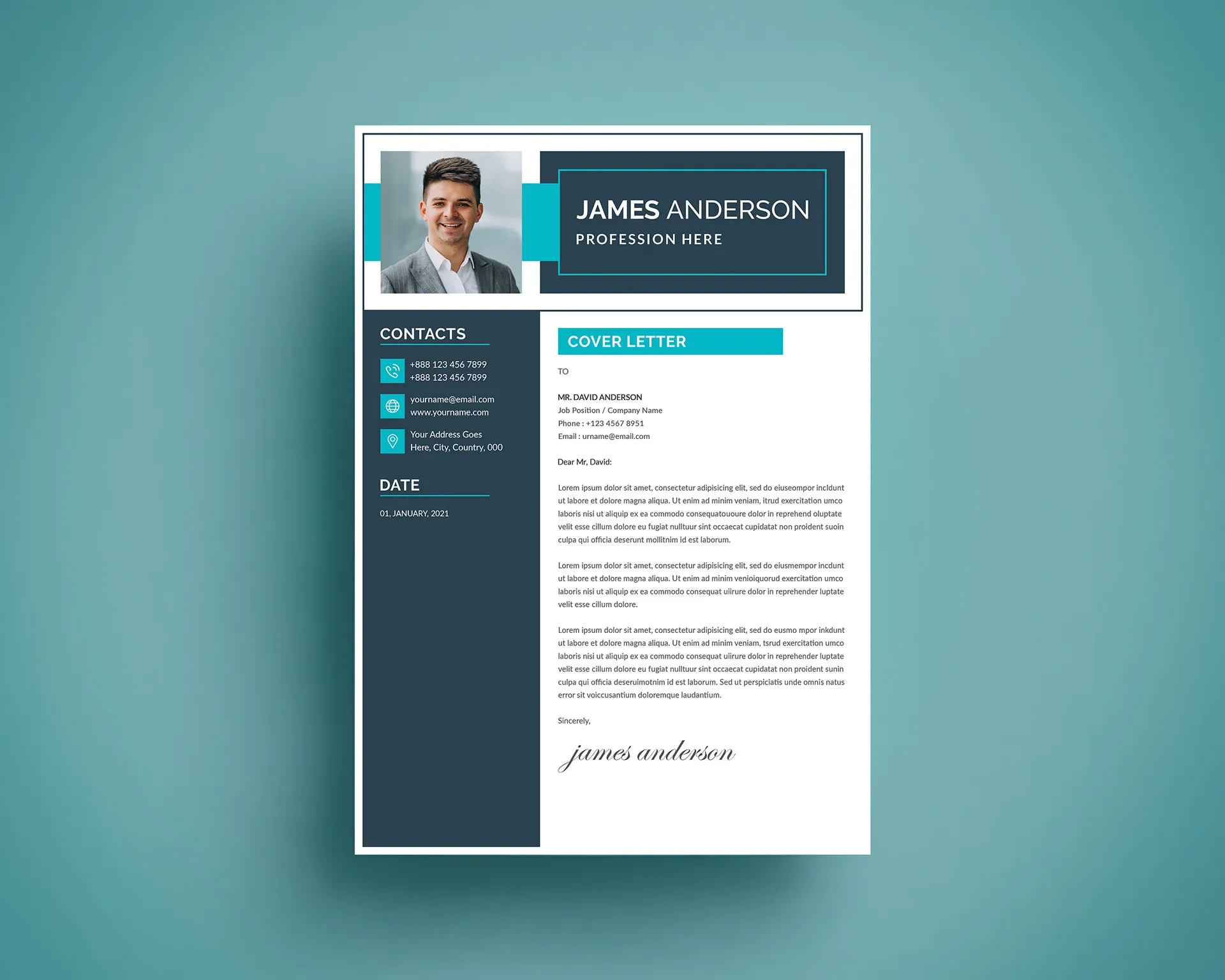Why a Business Cover Letter is Crucial
In the competitive world of job applications, a business cover letter is your first opportunity to make a lasting impression. It serves as more than just a formality; it’s a powerful tool that complements your resume by providing a narrative that showcases your personality, skills, and aspirations. A well-crafted cover letter can significantly increase your chances of landing an interview, as it allows you to explain your qualifications and how they align with the specific requirements of the role and the company’s needs. Unlike a resume, which is a static document, a cover letter allows you to express your enthusiasm and demonstrate why you are the ideal candidate for the position. It sets the tone for your application and gives the hiring manager a glimpse into your communication style and professionalism.
Highlighting Your Value Proposition
Your cover letter is the ideal place to clearly articulate your value proposition. This is where you highlight what you can offer the company. This goes beyond listing skills and experiences; it’s about demonstrating the specific benefits you can bring to the role. To effectively highlight your value, focus on how your skills and experiences align with the company’s needs and goals. Provide concrete examples of how you’ve achieved results in previous roles, quantify your accomplishments whenever possible, and explain how your expertise will help the company succeed. By showcasing your value proposition, you immediately grab the hiring manager’s attention and convince them that you’re a valuable asset worth interviewing. This approach ensures your application stands out from the competition.
Understanding the Cover Letter’s Purpose
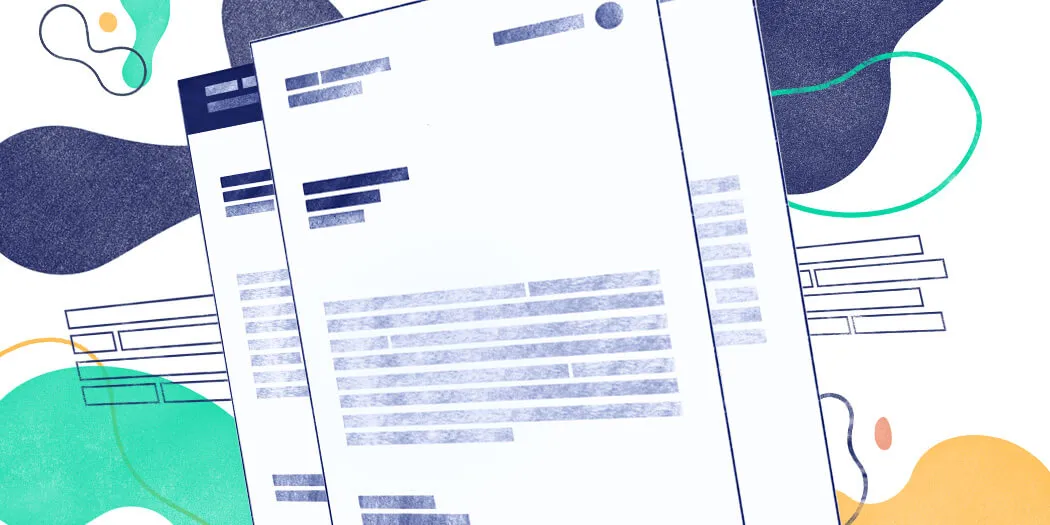
The primary purpose of a business cover letter is to introduce yourself to a potential employer and express your interest in a specific job opportunity. It’s your chance to expand on the information presented in your resume, providing context and demonstrating how your skills and experiences align with the requirements of the position. A cover letter should also be used to highlight your personality and communication style, giving the hiring manager a sense of who you are as a professional. It allows you to explain any gaps in your employment history, address any concerns the employer might have, and make a strong case for why you should be considered for an interview. A well-written cover letter can make a significant difference in the hiring process, as it demonstrates your enthusiasm, attention to detail, and genuine interest in the role and the company.
Researching the Company & the Role
Before you start writing your cover letter, it’s crucial to research the company and the specific role you are applying for. This research allows you to tailor your cover letter to the specific needs and values of the company, demonstrating your genuine interest in the position. Visit the company’s website, read their mission statement, and learn about their recent projects and achievements. Look at their social media profiles and online reviews to understand their culture and values. For the job description, thoroughly analyze the responsibilities and required qualifications. Identify the key skills and experiences the employer is looking for, and then reflect on how your qualifications align with their needs. This targeted approach shows that you have done your homework and are genuinely interested in contributing to their success.
Key Information Gathering
Gathering key information is essential for writing a compelling cover letter. Start by collecting all the necessary details about the job you are applying for. This includes the job title, the company name, and the name and contact information of the hiring manager, if available. Review the job description closely and make a list of the required skills, experiences, and qualifications. Also, collect information about your own achievements and accomplishments that are relevant to the job requirements. Be prepared to quantify your achievements with data and examples whenever possible. Make sure you have your resume, references, and any other necessary documents ready to attach. Gathering all this information in advance will help streamline the writing process and allow you to create a targeted cover letter that maximizes your chances of success.
Analyzing Job Descriptions
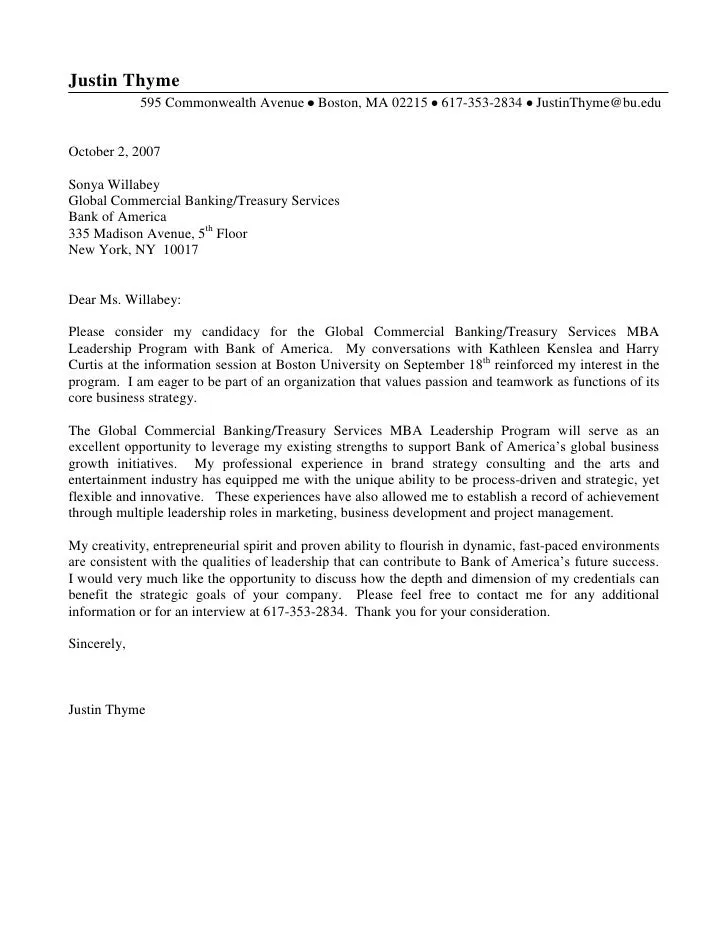
Analyzing job descriptions is a critical step in tailoring your cover letter to the specific requirements of the role. Start by carefully reading the job description and identifying the key skills, experiences, and qualifications the employer is seeking. Highlight the keywords and phrases that are repeatedly used, as these often indicate the most important aspects of the job. Compare your skills and experiences to the requirements listed in the job description and make a note of any gaps. Then, use these insights to structure your cover letter, ensuring you address each of the essential requirements and provide evidence of your ability to meet them. This focused approach not only demonstrates your understanding of the role but also shows your commitment to providing a cover letter that is specific and relevant.
Tailoring Your Cover Letter
Tailoring your cover letter to each job application is crucial for standing out from the competition. Generic cover letters are easy to spot and often get overlooked. To tailor your letter, start by thoroughly researching the company and the specific role. Then, carefully analyze the job description and identify the key requirements and keywords. Use this information to customize your cover letter, ensuring you highlight the skills, experiences, and qualifications that align with the employer’s needs. Refer to specific projects or achievements that demonstrate your ability to succeed in the role. By tailoring your cover letter, you show the hiring manager that you have taken the time to understand their needs and that you’re genuinely interested in the opportunity.
Formatting Your Business Cover Letter
The format of your business cover letter is just as important as its content. A well-formatted letter is easy to read and makes a professional impression. Start by using a clear and professional font like Times New Roman, Arial, or Calibri, with a font size between 10 and 12 points. Set consistent margins (typically 1 inch) and use single spacing. Your cover letter should be concise, ideally no more than one page. Include your contact information at the top, followed by the date and the hiring manager’s contact information. Use a professional salutation, such as “Dear Mr./Ms. [Last Name].” Divide the content into clear paragraphs, each focusing on a specific point. Ensure the letter is free of grammatical errors and typos. A well-formatted cover letter demonstrates your attention to detail and professionalism.
Selecting the Right Font and Style
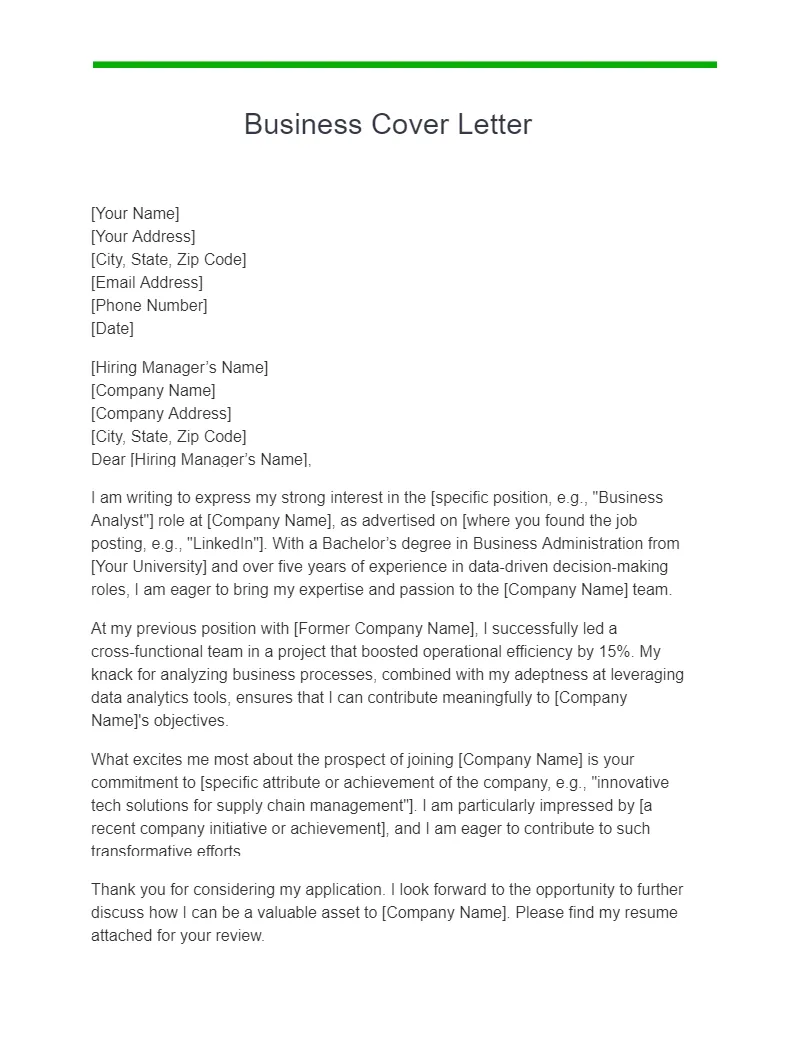
Choosing the right font and style is critical to creating a professional cover letter that is easy to read. Stick to classic, professional fonts such as Times New Roman, Arial, or Calibri, as these are universally accepted and easy on the eyes. Avoid overly stylized or decorative fonts, as they can be distracting and may appear unprofessional. Use a font size between 10 and 12 points, as this size is readable without taking up excessive space. Maintain consistency in your font choice throughout the entire document. Use bolding or italics sparingly, and only to emphasize important points. The goal is to create a clean and uncluttered design that allows the content to take center stage.
Structuring the Content
A well-structured cover letter guides the reader through your qualifications and leaves a lasting impression. Start with a compelling opening paragraph that grabs the hiring manager’s attention and states the position you are applying for. In the body paragraphs, highlight your most relevant skills and experiences, providing specific examples and quantifying your achievements whenever possible. Tailor each paragraph to the requirements outlined in the job description, demonstrating how your qualifications align with the company’s needs. Use clear and concise language, and organize your points logically. Conclude with a strong closing paragraph that restates your interest, expresses your enthusiasm, and includes a call to action. A well-structured cover letter is easy to follow and makes a strong case for your candidacy.
The Header and Salutation
The header and salutation of your cover letter set the tone for the rest of the document and are crucial for making a professional first impression. Your header should include your contact information, such as your name, phone number, email address, and LinkedIn profile URL (if applicable). Place this information at the top of the letter, either aligned to the left or right. Then, include the date, followed by the hiring manager’s name and title, and the company’s address. When addressing the hiring manager, use a formal salutation like “Dear Mr./Ms. [Last Name].” If you don’t know the hiring manager’s name, use “Dear Hiring Manager” or “Dear [Department Name] Team.” Avoid generic greetings such as “To Whom It May Concern” or “Dear Sir/Madam” as they lack personalization. The header and salutation should be polished and professional, setting the stage for a positive introduction.
Crafting a Compelling Opening

The opening paragraph of your cover letter is your chance to make a strong first impression and grab the hiring manager’s attention. Start by clearly stating the position you are applying for and where you found the job posting. Briefly mention your most relevant skill or experience, which directly aligns with the job requirements, to pique their interest. You can also express your enthusiasm for the opportunity or the company, showing that you have taken the time to research and understand their mission. Avoid generic or cliché phrases. Instead, aim for a concise and impactful opening that highlights your value proposition and encourages the reader to continue. A well-crafted opening immediately sets the tone for a compelling cover letter that showcases why you are the ideal candidate.
Highlighting Relevant Skills and Experiences
The body of your cover letter is where you highlight your relevant skills and experiences, demonstrating why you are the ideal candidate for the role. Start by identifying the key skills and experiences listed in the job description. Then, select the most relevant examples from your work history, academic achievements, or volunteer experiences. Describe each experience in detail, using the STAR method (Situation, Task, Action, Result) to provide context and demonstrate your accomplishments. Use action verbs to describe your responsibilities and accomplishments. Be specific, and quantify your achievements whenever possible to demonstrate the impact you made. For example, you could mention how you increased sales by a specific percentage or improved customer satisfaction scores. Tailor your examples to match the job requirements, ensuring that your cover letter resonates with the hiring manager.
Quantifying Achievements
Quantifying your achievements is one of the most effective ways to make your cover letter stand out. Instead of simply stating that you are good at something, use data and metrics to illustrate your accomplishments. Provide specific numbers and percentages to demonstrate the impact you have made in previous roles. For example, instead of saying you improved customer satisfaction, you could say, “Increased customer satisfaction scores by 15% within six months.” Quantifying your achievements provides concrete evidence of your skills and abilities, showing the hiring manager that you can deliver tangible results. This data-driven approach makes your cover letter more credible and impactful, illustrating your value proposition and demonstrating your potential.
Showcasing Your Enthusiasm
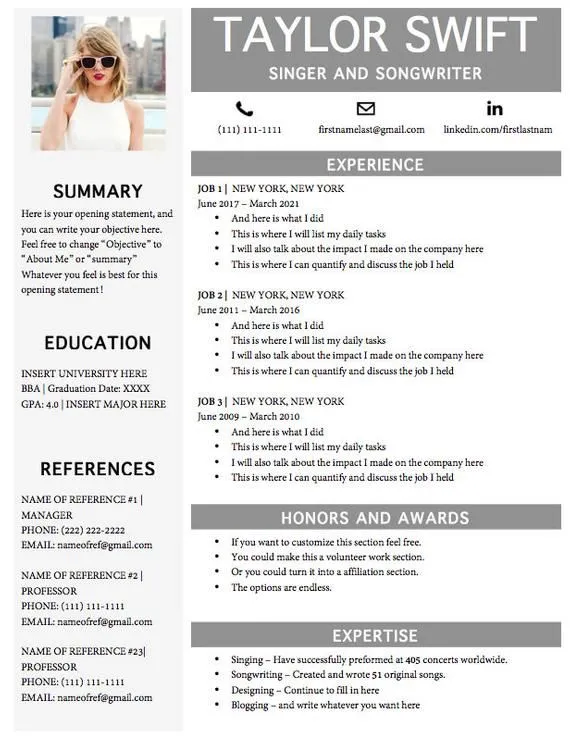
Showcasing your enthusiasm is crucial for making a positive impression on the hiring manager. Demonstrate your passion for the role and the company by expressing your excitement about the opportunity and highlighting what attracts you to the position. Mention specific aspects of the company’s mission, values, or recent projects that resonate with you. Show how your career goals align with the company’s objectives. Avoid generic statements. Instead, provide specific examples and reasons for your interest. Your enthusiasm can be conveyed through your choice of words, tone, and the overall positivity of your letter. A genuine display of enthusiasm conveys your dedication and commitment, making you a more attractive candidate.
Writing a Strong Closing Statement
The closing statement of your cover letter is your final opportunity to leave a lasting impression on the hiring manager. It should reiterate your interest in the position, summarize your key qualifications, and express your enthusiasm for the opportunity. Reiterate your value proposition and how you align with the company’s needs. In your closing, include a call to action, such as requesting an interview or expressing your willingness to provide additional information. Keep the tone professional and confident, and thank the hiring manager for their time and consideration. Finish with a professional closing like “Sincerely,” “Best regards,” or “Thank you.” A strong closing statement reaffirms your interest and encourages the hiring manager to take the next step, which is to consider you for an interview.
Proofreading and Editing
Proofreading and editing are essential steps in the cover letter writing process. Before submitting your cover letter, carefully review it for any errors in grammar, spelling, punctuation, and formatting. Read it multiple times, paying close attention to each sentence and paragraph. Consider reading it aloud to catch awkward phrasing or sentence structure issues. Use a spell checker and grammar checker to identify potential mistakes. However, don’t rely solely on these tools; proofread manually to ensure accuracy. Ask a friend, family member, or career counselor to review your cover letter for feedback. Proofreading demonstrates your attention to detail and professionalism. A polished, error-free cover letter makes a positive impression and shows you take pride in your work, increasing your chances of getting the job.
Ensuring Grammatical Accuracy
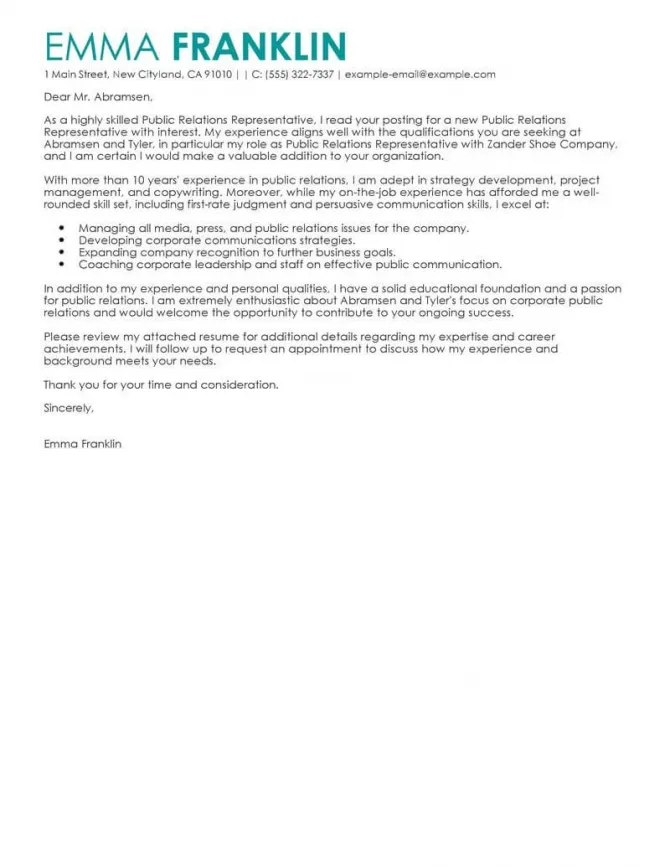
Ensuring grammatical accuracy is critical in the cover letter. Errors in grammar, spelling, and punctuation can distract the reader and undermine your credibility. Double-check your letter for proper sentence structure, correct verb tenses, and accurate subject-verb agreement. Be mindful of the use of commas, semicolons, and other punctuation marks to ensure your writing is clear and easy to understand. Use a spell checker and grammar checker, but don’t rely on them entirely. Proofread carefully, and look for any typos, inconsistencies, or awkward phrasing. Consider asking a friend, family member, or career counselor to review your cover letter for grammatical errors. A grammatically correct cover letter demonstrates your professionalism and attention to detail, boosting your chances of making a positive impression.
Seeking Feedback
Seeking feedback is an essential step in the cover letter writing process. Ask trusted friends, family members, or career advisors to review your cover letter. Provide them with the job description and ask them to assess whether your letter effectively addresses the requirements of the role and highlights your relevant skills and experiences. Ask for feedback on the clarity, conciseness, and overall impact of your cover letter. Pay attention to any comments about grammar, spelling, punctuation, and formatting. Be open to suggestions and willing to revise your cover letter based on the feedback you receive. Incorporating constructive feedback can significantly improve your cover letter, helping you create a more compelling and effective document that increases your chances of getting the job.
Avoiding Common Mistakes
Avoiding common mistakes is critical for making a positive impression with your cover letter. One of the most common errors is using generic templates. Tailor each cover letter to the specific job and company, highlighting your skills and experiences relevant to the position. Avoid using generic language and instead provide concrete examples of your achievements and how they align with the company’s needs. Another common mistake is ignoring the job description. Ensure you address all the key requirements listed in the job description and showcase your ability to meet them. Over-selling or exaggerating your skills is also a mistake. Be honest and provide factual information about your accomplishments. Submitting your cover letter without proofreading for errors can damage your credibility. Always carefully review your cover letter before submitting it.
Using Generic Templates
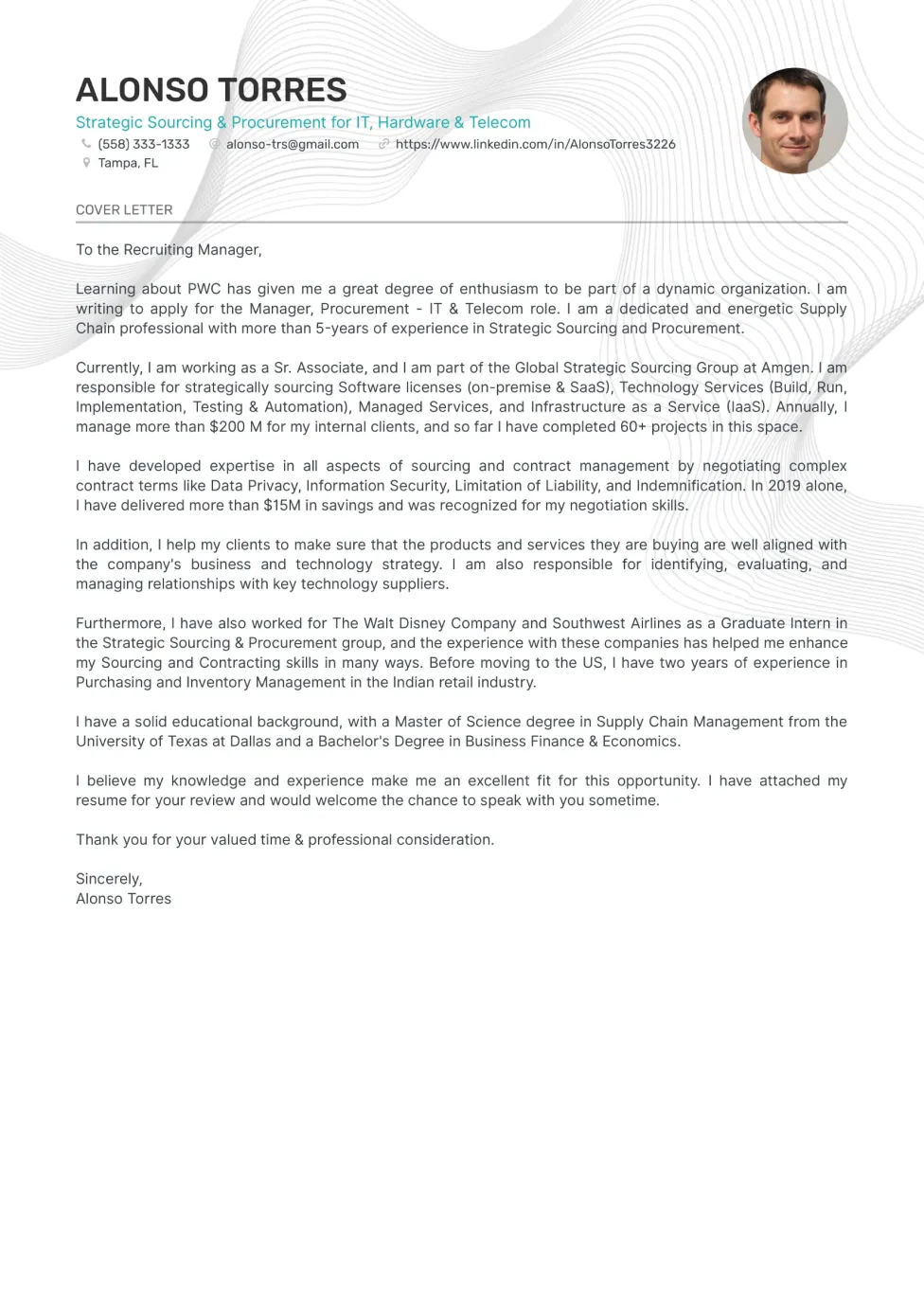
Using generic templates is one of the biggest mistakes you can make when writing a business cover letter. While templates can provide a basic structure, using a generic one without tailoring it to the specific job and company shows a lack of effort and personalization. Hiring managers can easily spot a generic cover letter, which often leads to it being discarded. Instead, customize your cover letter to highlight the skills, experiences, and achievements that align with the job requirements. Research the company and tailor your language to resonate with their values and culture. By personalizing your cover letter, you demonstrate that you have taken the time to understand the opportunity, making a stronger impact and increasing your chances of getting an interview.
Ignoring the Job Description
Ignoring the job description is another significant mistake to avoid when writing your business cover letter. The job description is your roadmap for crafting a compelling cover letter. It outlines the specific requirements, skills, and experiences the employer is seeking. Failing to address these key elements will likely result in your application being overlooked. Before you begin writing, carefully analyze the job description and identify the essential qualifications. Then, tailor your cover letter to highlight the skills, experiences, and achievements that align with these requirements. Provide specific examples to show how you have successfully met similar challenges in previous roles. By addressing each point in the job description, you demonstrate your ability to meet the employer’s needs, increasing your chances of getting an interview.
Over-Selling or Exaggerating
Over-selling or exaggerating your qualifications can be detrimental to your job application. While it’s important to showcase your skills and achievements, be honest and accurate in your claims. Avoid making exaggerated statements or overstating your abilities, as this can damage your credibility. If you are asked to provide examples of your success, provide facts and data to back it up. If you are unsure about a certain skill, it’s best to admit it. Be honest about your limitations, focusing on your strengths and how you can add value to the company. A truthful and straightforward cover letter will build trust with the hiring manager and create a strong foundation for a successful interview.
Submitting Without Proofreading
Submitting your cover letter without proofreading is one of the most common and easily avoidable mistakes. Errors in grammar, spelling, punctuation, and formatting can immediately damage your credibility and make you appear unprofessional. Before submitting your cover letter, carefully review it multiple times, paying attention to every detail. Read it aloud to check for awkward phrasing or sentence structure issues. Use a spell checker and grammar checker as tools, but don’t rely on them entirely. Proofread manually, and if possible, ask a friend, family member, or career advisor to review your cover letter for feedback. Proofreading demonstrates your attention to detail and your commitment to presenting yourself professionally, increasing your chances of success.
Business Cover Letter Best Practices
Following best practices is crucial for creating an effective business cover letter that gets results. Tailor each cover letter to the specific job and company. Research the company and the role, and customize your letter accordingly. Use clear and concise language, making sure your writing is easy to read and understand. Highlight your most relevant skills and experiences, and provide concrete examples of your achievements. Quantify your accomplishments whenever possible, using data and metrics to show the impact you have made in previous roles. Proofread and edit carefully, and be sure to check for any errors in grammar, spelling, or punctuation. Demonstrate enthusiasm, and make sure your interest in the opportunity is clear. Finally, always include a call to action, requesting an interview or expressing your willingness to provide additional information.
Dos and Don’ts
When writing a business cover letter, it’s helpful to know the dos and don’ts to maximize your impact. Do tailor your cover letter to each specific job. Do research the company and the role. Do highlight your relevant skills and experiences and quantify your achievements. Do use clear and concise language, and ensure your letter is free of errors. Do express your enthusiasm and include a call to action. On the other hand, don’t use generic templates or copy and paste from other sources. Don’t ignore the job description. Don’t over-sell or exaggerate your qualifications. Don’t submit your letter without proofreading. Finally, avoid lengthy paragraphs and generic statements. By following these tips, you can create a compelling cover letter that helps you stand out from the competition.
Business Cover Letter Final Checklist
Before submitting your business cover letter, use a final checklist to ensure you haven’t missed any important details. Make sure your contact information is accurate and up-to-date. Verify that you’ve included the date and the hiring manager’s contact information. Ensure that your salutation is professional and personalized. Confirm that your opening paragraph grabs the reader’s attention and clearly states the position you are applying for. Check that you have highlighted your most relevant skills and experiences, and that you have provided specific examples and quantified your achievements whenever possible. Proofread the entire document for any grammatical errors, spelling mistakes, or formatting inconsistencies. Confirm that you have expressed your enthusiasm and included a call to action. Finally, ask a friend, family member, or career advisor to review your cover letter for feedback. A final checklist helps guarantee that your cover letter is polished and professional.
